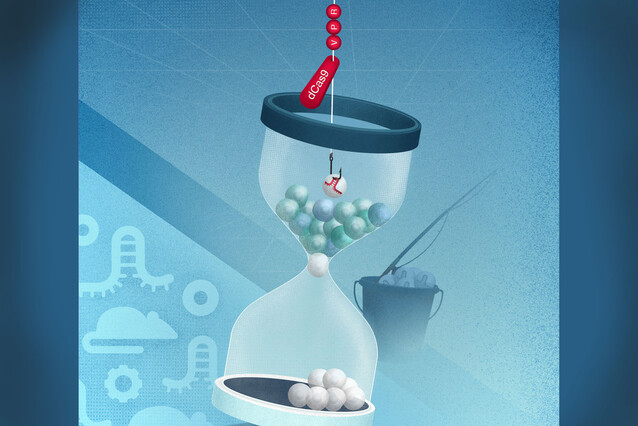CaTCH - a molecular time machine for cells
Researchers from the IMP's Obenauf-lab and collaborators have developed a tool that lets them trace millions of cells as they undergo evolutionary selection processes with the ability to retrospectively isolate and functionally analyse their precursors. In first applications, the technique was used to investigate how resistance to targeted cancer therapies arises.
Metastasis, the final stage of cancer progression, is responsible for more than 90 percent of cancer-related deaths. The treatment of metastatic cancer has changed considerably in recent years. Unspecific cytotoxic chemotherapies have been replaced by targeted therapies that interfere with specific molecules involved in the growth and spread of cancer cells. In many cancer types, these therapies are able to control tumour growth for several months, but long-term survival rates of metastatic patients remain disappointingly low. This is due to the emergence of aggressive, drug-resistant cancer cell-clones that drive relapse and rapidly form new metastases.
One of the questions that clinicians and researchers are keen to answer is how this resistance comes about. Are resistant cell-clones present in the primary tumour and selected by administering therapeutic drugs, or are resistant traits acquired in the course of treatment? To find out, the strategy seems quite straightforward: a population of cancer cells is treated until it becomes resistant to the drug. The resistant cells are then compared to their precursors in the naïve, untreated tumour. But identifying and isolating these so-called founder cells is by no means easy, especially if you want them alive.
Tracing millions of cells
To address this problem, scientists from the lab of Anna Obenauf at the Research Institute of Molecular Pathology (IMP) in Vienna and collaborators have developed a novel technique named CaTCH (CRISPRa tracing of clones in heterogeneous cell populations). This method combines precise clone tracing of millions of cells with the ability to retrospectively isolate alive founder clones prior to and during evolutionary selection. In a paper published in the current issue of Nature Biotechnology, the authors present their technique and the results of a study.
When employing CaTCH, each cell in a large and heterogeneous population is labelled with a genetic barcode, a short DNA-sequence that is stably integrated into the genome. This barcode functions as a unique identifier that lets each cell be tracked through space and time. At any stage, the identity of the cell can be easily established by next generation sequencing. Coupled to the barcode is a reporter-protein which, when activated, emits fluorescent light. This turns the barcode into a functional switch which can be used to isolate specific cells alive. To find and turn on the switch, the researchers utilized the power of the CRISPR-Cas9-system. Specially designed guide-RNAs lead an activator-molecule to the barcode-reporter in the clone of interest. The resulting expression of the fluorescing protein makes the cell light up and it can be isolated alive by a FACS cell-sorter. By preserving cells before or during experimental selection, the founders of selected clones can be identified at any stage of the selection process.
A molecular time machine
"We have created a veritable time-machine for cells", says first author Christian Umkehrer, a doctoral student in the lab of Anna Obenauf. "When traditional lineage tracing methods are applied, cells are tagged in a way that lets us identify all progeny of a single cell. CaTCH also does the reverse and lets us find the precursor for each individual cell." The method has proved to be extremely sensitive, capturing rare clones representing as little as 0.001% of a population.
For their study, the authors used a genetically engineered mouse melanoma model to investigate the emergence of resistance to a targeted therapy regimen. Two classes of drugs, RAF- and MEK-inhibitors, are frequently used to treat melanoma. However, in the clinic patients often acquire resistance to these drugs, and the same is true for mice. Using CaTCH, the researchers found that resistance to RAF- and MEK-inhibitors largely does not arise from selection of pre-existing resistant clones but is an acquired state. This has consequences for the development of therapeutic approaches. Strategies that interfere with such adaptation processes could improve the durability of treatment responses.
“We are very excited about these first results and grateful for the support of the European Research Council and the IMP, which made this possible. The idea for CaTCH was sparked by scientific curiosity for a long-standing question in cancer biology but I envision possible future applications of CaTCH to range from basic biology to regenerative medicine, for example to shed light on clonal selection and adaptation processes during metastasis, reprogramming and differentiation", says Anna Obenauf.
Original Publication:
Umkehrer C, Holstein F, Formenti L, Jude J, Froussios K, Neumann T, Cronin SM, Haas L,Lipp JJ, Burkard TR, Fellner M, Wiesner T, Zuber J, Obenauf AC. CaTCH - A barcode-guided CRISPRa-inducible reporter to isolate clones from heterogeneous populations. Nature Biotechnology, 27 July 2020. DOI 10.1038/s41587-020-0614-0
About the Vienna BioCenter PhD Programme
Much of the work underlying this publication was done by a doctoral student of the Vienna BioCenter PhD Programme. Are you interested in a world-class career in molecular biology? Find out more: https://training.vbc.ac.at/
